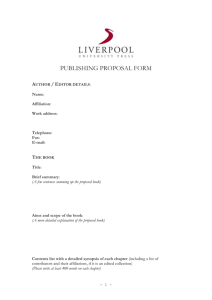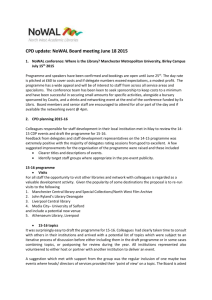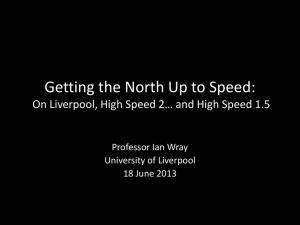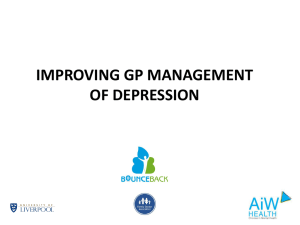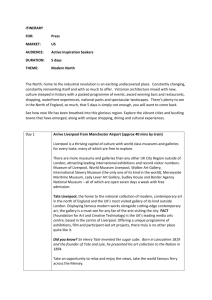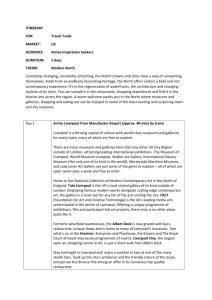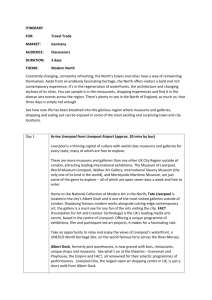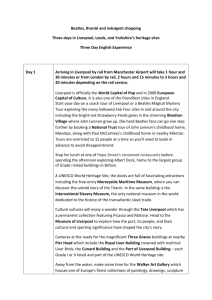northwest microbiology 2014 conference programme
advertisement
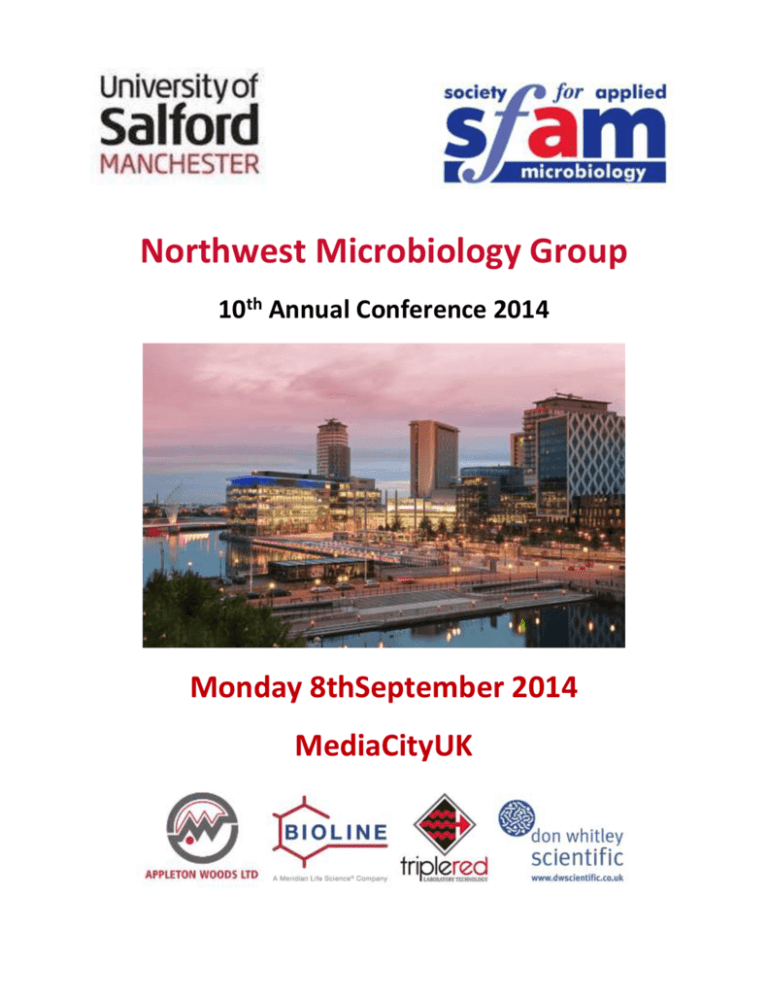
Northwest Microbiology Group 10th Annual Conference 2014 Monday 8thSeptember 2014 MediaCityUK PROGRAMME 08:30 REGISTRATION 09:30 Welcome and Housekeeping 9.45 - 11:00 Microbial Pathogens Laura Bricio Moreno African Streptococcus pneumoniae Serotype-1 in nasopharyngeal carriage and invasive disease in murine models of infection Emily Davies Long-term coevolution of Pseudomonas aeruginosa and temperate bacteriophages in artificial sputum David Williams Population structure of P. aeruginosa during chronic infections of the airways of cystic fibrosis patients inferred by whole genome sequencing Jessica Hall Exploring the spatial and temporal variations in Borreliaburgdorferi in Ixodesricinus in north west England Claire Scantlebury Tackling Epizootic Lymphangitis in Horses; new approaches to aid detection of Histoplasmacapsulatumvarfarciminosum direct from equine clinical samples 11-11:45 COFFEE BREAK 11:45-1:00 Host-pathogen Interactions Jane King Heterogeneous expression of capsule by uropathogenicEscherichia coli a fitness strategy? Yvette Merga A sticky business: Adherent, Invasive E. coli in Crohn’s Disease Carsten Kröger An Infection-Relevant Transcriptomic Compendium for Salmonella enterica serovarTyphimurium Shabarinath Srikumar Chloe James Chair: Prof Richard Birtles Chair: Dr Nicky High The primary transcriptome of Salmonella Typhimurium within macrophages identifies a genus specific sRNA that controls acid resistance and virulence Deborah Cantu The Campylobacter jejuniglpTpseudogene encodes a functional protein required for the utilisation of 3-phosphoglycerate Suzanna Gore Augmented passive immunotherapy for the treatment of severe bacterial infections. 1:00-2:15 LUNCH 2:15 - 3:30: Microbial Community Analysis Chair: Prof Alan McCarthy Tracy Perkins The role of estuarine sediments as a reservoir for pathogenic microorganisms Ashley Houlden Brain Injury induces specific changes in the caecalmircoflora of mice Ryan Joynson Metagenomic analysis of the gut microbiome of the common black slug Arionater in search of novel lignocellulose degrading enzymes Anshul Gupta Metagenomic and metatranscriptomic analysis of cellulose degradation in Landfill Emma Ransom-Jones Characterising the oak microbiome; towards an understanding of Acute Oak Decline 3:30 - 4:30 TEA BREAK and SCIENCE CAKES 4:30 - 5:15 Steve DiggleKeynote speech: “Cooperation and conflict in bacterial populations” 5:15 - 5:30 Prizes and close 5:30 - 6:30 WINE RECEPTION ABSTRACTS FOR ORAL PRESENTATIONS Session 1: Microbial Pathogens African Streptococcus pneumoniae Serotype-1 in nasopharyngeal carriage and invasive disease in murine models of infection Laura Bricio-Moreno University of Liverpool Streptococcus pneumoniae is a common inhabitant of the nasopharynx of healthy individuals but can also cause serious diseases such as pneumonia, meningitis and septicaemia in children, the elderly and the immuno-compromised. Pneumococcal serotype-1 is one of the main causes of invasive pneumococcal disease in sub-Saharan Africa, but unlike other serotypes, it is rarely found in carriage. The first aim of this study is to understand whether African serotype-1 isolates carry in the nasopharynx and if they do so how they interact with host immunity during carriage, whilst the second aim is to understand how African serotype-1 isolates progress into invasive pneumococcal disease. Serotpye-1 exhibits geographically distinct clonal populations. For that reason we have used isolates from Malawi and the Gambia, as well as different sequence types to analyse the overall in vivo dynamics of serotype-1 Long-term coevolution of Pseudomonas aeruginosa and temperate bacteriophages in artificial sputum E. V. Davies1,2, C. E. James3, M. A. Brockhurst4, S. Haldenby2, S. Paterson2& C. Winstanley1. Institute of Infection and Global Health, University of Liverpool; 2Institute of Integrative Biology, University of Liverpool; 3School of Environment and Life Sciences, University of Salford; 4Department of Biology, University of York. 1 Pseudomonas aeruginosa is capable of causing chronic lung infections in individuals affected with Cystic Fibrosis (CF), that once established are almost impossible to eradicate. Over time, P. aeruginosa adapts to the unique CF lung environment and undergoes extensive diversification, yet the factors driving this remain incompletely understood. The Liverpool Epidemic Strain (LES) is a particularly virulent and transmissible strain that is notable for the presence of multiple prophages, of which several have been implicated in the in vivo competitiveness of the strain. Bacteriophages are known to drive bacterial diversification, but the role they play in the evolution of P. aeruginosa populations is unclear. We took an experimental evolution approach by constructing a model of chronic CF infection, coevolving the well-characterised reference strain PAO1 with three LES phages in Artificial Sputum Media (ASM) for 240 bacterial generations. Multiple isolates were selected from each endpoint population and subjected to phenotypic characterisation and pooled for sequencing, allowing for a comparison of intrapopulation diversity and evolution in the presence or absence of phages. We identified genetic changes common to chronic CF isolates, as well as evidence of phage-driven adaptation to the artificial sputum environment. Population structure of Pseudomonasaeruginosa during chronic infections of the airways of cystic fibrosis patients inferred by whole genome sequencing David Williams1, Benjamin Evans1,2, Sam Haldenby1, Martin J. Walshaw3, Michael A. Brockhurst4, Craig Winstanley5, Steve Paterson1 1 Institute of Integrative Biology, University of Liverpool, 2Department of Life Sciences, Anglia Ruskin University, 3 Liverpool Heart and Chest Hospital NHS Foundation Trust, 4 Department of Biology, University of York, 5Institute of Infection and Global Health, University of Liverpool Pseudomonas aeruginosa are the predominant cause of recalcitrant infections of the mucus-rich airways of individuals with cystic fibrosis. These infections are characterised by acute and chronic stages leading to high rates of morbidity and mortality but little is known about population-level diversity and its potential contribution to clinical outcomes. We examined the diversity within sets of 40 Liverpool Epidemic Strain P. aeruginosa isolate genome sequences, mostly pooled, from numerous sputum samples to infer population structure and evolutionary processes within infections. A prevalence of genetically distinct but co-existing P. aeruginosa lineages among sputum samples from nine CF patients is evident from population-level comparisons of genome sequences. Reconstruction of the genealogy of these well-defined sub-populations reveals distinct origins and a complex history of transmissions affecting the sampled patients. Previous reports have demonstrated the transmissability of P. aeruginosa among CF patients and the ability of the pathogens to displace each other during the course of a chronic infection. The coexistence of genetically distinct populations within individual patients revealed by our population-level analysis is consistent with newly acquired P. aeruginosa infections persisting with previously contracted infections within the airway of a patient. Exploring the spatial and temporal variations in BorreliaburgdorferiinIxodesricinus in north west England Jessica Hall University of Salford Borreliaburgdorferisensulato (s.l.) group of spirochetes are the causative agents of the ticktransmitted zoonosis Lyme borreliosis, of which an estimated 3000 cases occur annually in the UK. Ixodesricinus is the principal vector of B. burgdorferis.l. in the United Kingdom, and this tick species is widely distributed across the country. The main aim of this project was to investigate the temporal and spatial dynamics of B. burgdorferi populations in Ixodesricinusin Cumbria. Questing Ixodesricinus ticks were collected at 3 sites in southern Cumbria every four weeks and tested for the presence of B. burgdorferigenospecies using realtime PCR and reverse line blot analysis. The prevalence of B. burgdorferi infections in ticks at each site ranged from 0.0% to 14.03%. Four genospecies, B. afzelii, B. burgdorferisensustricto, B. garinii and B. valaisiana, were detected across the region although the contribution that each genospecies made to the borrelial population at each site varied markedly. To assess the public health impact a questionnaire was sent to GP’s in the areas to quantify the cases of LB around the survey site in the last three years the data showed that 59 cases of LB had been diagnosed, 84 cases of LB were suspected and over 295 ticks had been removed from patients. B. burgdorferis.l. appears to be a threat to public health in the southern Cumbria area. Tackling Epizootic Lymphangitis in horses; new approaches for a neglected disease with major welfare and social impact. C.E. Scantleburya, G.L. Pinchbeckb, R.M. Christleyb, A.P. Stringerc, N. Aklilud, T. Ashined, P. Loughnanea, L. Gordona, A.J. McCarthya. a Institute of Integrative Biology, University of Liverpool,b Institute of infection and global health, University of Liverpool, Leahurst,c SPANA UK, London,d SPANA Ethiopia, College of Veterinary Medicine and Agriculture, Addis Ababa University, Epizootic Lymphangitis (EZL) caused by Histoplasmacapsulatum var. farciminosum (HCF), is endemic within Ethiopia. Despite its high prevalence, EZL is under-researched and disease control strategies are limited. This project aimed to develop rapid methods for diagnosing EZL to facilitate future studies. Blood samples and pus aspirates were obtained from 29 horses with suspected EZL from several regions of Ethiopia. DNA extracts were prepared using a commercial kit. Blood was also collected from 20 horses with no EZL lesions. Aliquots of blood and heat-treated pus were inoculated onto Whatman FTA cards. A nested PCR targeting the ITS region was used to identify HCF. Twenty-six of 29 horses with suspected EZL were confirmed by DNA sequencing of amplimers. To date, 9 blood samples have also been confirmed positive. Bioinfomatic analysis will explore diversity among the samples and examine correlations with clinical data. The performance of the PCR between clinically suspected and unaffected horses will also be reported. These findings demonstrate the use of PCR to diagnose HCF directly from equine samples. Whatman FTA technology was successfully adapted for use with equine pus and allowed downstream molecular analyses. The identification of HCF in blood warrants further investigation of the organism’s pathogenicity in horses. Session 2: Host-pathogen Interactions Heterogeneous expression of capsule by uropathogenicEscherichia coli - a fitness strategy? Jane King University of Manchester UropathogenicEscherichia coli (UPEC) are the predominant cause of urinary tract infections. The K1 polysaccharide capsule on the surface of UPEC strain UTI89 is a key virulence factor and evidence suggests its expression may be regulated both spatially and temporally during UTI. We sought to follow capsule gene expression during UTI from extracellular growth in urine to intracellular growth in bladder epithelial cells using a green fluorescent protein (gfp) fusion to the capsule gene promoter. We found there is an average down regulation of capsule expression in urine compared to growth in rich media (LB), but when examined at the single cell level, in both media, the capsule genes appear to be expressed in a non-uniform manner. Using anti-K1 antibody we show this heterogeneity in gene expression is reflected on the cell surface where phenotypic diversity of capsule is observed. In fact around 4% of UTI89 routinely appear un-encapsulated in urine (1% in LB) and we present evidence that these capsule minus bacteria are the initial colonizers both in a biofilm model and to bladder epithelial cells. We propose that this physiological diversity in capsule ensures that at least some of the bacterial cells have the appropriate phenotype under a given environment hence increasing the strain’s fitness during UTI. A Sticky Business: Adherent, Invasive E. coli in Crohn’s Disease Yvette Merga Department of Gastroenterology, Institute of Translational Medicine, University of Liverpool Crohn’s disease (CD) is a painful and debilitating inflammatory disease of the gastrointestinal tract, affecting ~1 in 650 people in the UK. Thought to be caused by a combination of environmental, immunological and host genetic factors, CD is characterised by granulomatous lesions in the gut mucosa and dysbiosis (imbalance of the gut microbiota); specifically a reduction in Firmicutes and overabundance of Proteobacteria, particularly increased numbers of adherent, invasive E. coli (AIEC). Whilstlacking key virulence genes characteristic of diarrhoeagenicE. coli, isolates from CD patients promote inflammation, invade the epithelium and possess the ability to survive and replicate within mucosal macrophages. Isolates also form granulomas in vitro characteristic of early Crohn’s lesions. The portal of entry across the gut mucosa is through specialised microfold (M)-cells of the follicleassociated epithelium overlying Peyer’s patches in the ileum and lymphoid follicles in the colon. The interaction of AIEC with M cells is dependent on possession of long polar fimbriae (Lpf). However, receptors for AIEC Lpf remain a mystery. I aim to identify Crohn’s AIEC Lpf interactions with M cells using extracted intestinal glycolipids/proteins, bacterial overlay assays and mass spectrometry. Blockade of bacterial entry via M-cells represents an important potential target for Crohn's therapies. An Infection-Relevant Transcriptomic Compendium for Salmonella entericaserovarTyphimurium Carsten Kröger1,4, Aoife Colgan1, Shabarinath Srikumar1, Kristian Händler1, Sathesh K. Sivasankaran1, Disa L. Hammarlöf4, Rocío Canals4, Joe E. Grissom2, Tyrrell Conway2, Karsten Hokamp3 and Jay C. D. Hinton1,4 1 Moyne Institute of Preventive Medicine, Trinity College Dublin, 2Department of Microbiology and Plant Biology, University of Oklahoma, USA, 3Smurfit Institute of Genetics, Trinity College Dublin, 4 Institute of Integrative Biology, University of Liverpool UK. The advent RNA-sequencing allows bacterial transcription to be studied at the level of the individual nucleotide in the context of the millions of nucleotides that comprise the genome. Because bacterial gene expression is remarkably sensitive to environmental conditions, we combined information from bacteria exposed to multiple environmental factors to gain a complete picture of the transcriptome. We devised a suite of 22 infection-relevant growth conditions that stimulate characteristic expression profiles of the Salmonella entericaserovarTyphimuriumvirulence. Overall, the suite of conditions induced the transcription of 86% of S.Typhimurium genes [1]. The differential RNA-seqtranscriptomic approach has recently facilitated the large-scale identification of bacterial small RNAs and promoters [2,3]. We present a new simplified approach for global promoter and small RNA identification that identified the majority of bacterial promoters and sRNAs in just two RNA-seq experiments. This global approach revealed that transcription of the majority of the 3825 S. Typhimurium promoters is environmentally-responsive and the expression patterns of 280 sRNAs which we analysed in the context of their chromosome localisation and Hfq-association. The levels of environmentally-controlled expression of every coding gene and sRNA of S. Typhimurium are now available as an online resource for the research community. [1] Krögeret al. (2013) Cell Host Microbe. 14:683-95 [2] Sharma et al. (2010) Nature. 464:250-5 [3] Krögeret al. (2012) PNAS. 109:E1277-86 The primary transcriptome of Salmonella Typhimurium within macrophages identifies STnc1850, a genus specific sRNA that controls acid resistance and virulence Shabarinath Srikumar1,2, Carsten Kröger1,2, Magali Hébrard1, Aoife Colgan1, Michael Beckett1, Laura Luque1, Lu Wang3, Sathesh K Sivasankaran1, Katie Breen1, Daoguo Zhou3, Andrew D. S. Cameron4, Karsten Hokamp1, Jay C. D. Hinton1, 2 # 1 2 Moyne Institute of Preventive Medicine, Ireland. University of Liverpool, UK. 3Purdue University, West Lafayette, USA.4University of Regina, Saskatchewan, Canada. Salmonella enterica is the best-studied bacterial pathogen, but crucial details about the genetic programs it uses to persist in macrophage have remained obscure due to the difficulty of studying intracellular pathogens. Here we report the first use of deep sequencing of cDNA (RNA-seq) to interrogate the transcriptional architecture and gene activity of Salmonella in macrophage, thus providing unprecedented insight into the strategies used by the pathogen to survive in the very immune cells that seek to destroy it.Analysis of the gene expression of 282 S. Typhimurium small RNAs showed that, a novel Salmonella specific sRNA, STnc1850, is required for macrophage survival and mouse infection; by modulating acid resistance and persister formation. We identified 31 S. Typhimurium genes that are strongly induced inside macrophage but are expressed at low levels in diverse in vitro conditions. We also characterized 3583 transcriptional start sites that are active within macrophages and 11 of these are excellent candidates for the delivery of heterologous antigens from Salmonella vaccine strains. The Campylobacter jejuniglpTpseudogene encodes a functional proteinrequired for the utilisation of 3-phosphoglycerate Deborah Cantu University of Manchester Campylobacter jejuni is the most common bacterial cause of gastrointestinal illness worldwide. Despite of its importance, the exact nutritional and metabolic requirements for this pathogen remain poorly understood. The current knowledge of C. jejuni metabolism indicates that it lacks enzymes and transporters needed to metabolize glucose and galactose via the glycolytic pathway thought it may utilize other energy sources such as 3-phosphoglycerate which requires only the lower part of the glycolytic pathway. Recently the C. jejuni adhesin PEB3 was shown to bind 3-phosphoglycerate (3PG) and this protein was necessary for 3-PG dependent growth promotion. The exact role of PEB3 in utilisation of 3PG was not defined. Intriguingly the peb3 gene is located adjacent to a glpT gene that encodes a putative phosphoglycerate transporter however, at least in strain NCTC 11168, this is designated as a pseudogene. In this study we investigated the role of peb3 and glpT and identified two independent phenotypes, the ability to utilise 3PG for growth and sensitivity to fosfomycin, that require glpT but not peb3. Our findings therefore show that the NCTC 11168 glpTpseudogene despite containing two frameshift mutations has the capacity to encode a functional protein. Augmented passive immunotherapy for the treatment of severe bacterial infections. S. Gore1, B. Morton2, D. Neill1, M. Bangert1, 2, G. Rajam3, E. Ades3, S. Gordon2, A. Kadioglu1. Institute of Infection and Global Health, University of Liverpool; 2Respiratory Infection Group, Liverpool School of Tropical Medicine; 3Division of Bacterial Diseases, Centers for Disease Control and Prevention, Atlanta, GA, USA. 1 Background: Antibacterial resistance is increasing and novel therapeutic strategies are urgently needed for the treatment of severe bacterial infections. One strategy that has shown much promise is P4 peptide therapy. P4 peptide increases expression of Fcγ receptors on phagocytes leading to a significant increase in opsonophagocytosis of the pathogen when combined with pathogen specific antibody. In animal models of pneumococcal pneumonia, treatment with P4 peptide therapy resulted in increased survival and prevented progression to sepsis.This project goes on to look at the efficacy of P4 treatment against Gram-negative infections and ex vivo assessment of P4 efficacy in a cohort of ICU patient. Methods: P4 peptide efficacy was assessed through murine models of acute infection and opsonophagocytosis killing assays with neutrophils isolated from patients admitted to ICU with community-acquired pneumonia. Results: In murine models co-administration of the P4 peptide with antibiotics increased 24 hour survival from 10% to 60% and increased 7 day survival from 20% to 70% when compared with antibiotic treatment alone for E.coli and K. pneumoniae respectively. Ex vivo treatment of neutrophils from community-acquired pneumonia patients with P4 peptide resulted in 65% of patients displaying an increase in phagocytosis with 50% of those patients showing an increase in phagocytosis of more than 2 fold. Conclusion: P4 peptide therapy significantly increased both survival in murine models and phagocytic killing in patients with severe community-acquired pneumonia. This novel adjunct therapy specifically boosts the host innate immune response to infection, enhancing bacterial killing and has potential as a future treatment. Session 3: Microbial Community Analysis The role of estuarine sediments as a reservoir for pathogenic microorganisms Tracy Perkins University of Bangor Using both culturable and molecular methods to determine the abundance and spatial variation of microbial pathogens in relation to sediment composition within an estuarine environment. Microbial pathogens present in faecal matter can contaminate estuarine environments via a number of point and diffuse sources. Once in the water column attachment of bacteria to suspended particles can facilitate their settling into sediments, which can enhance their survival. Estuarine sediments represent a significant reservoir for pathogenic bacteria and resuspension under certain hydrodynamic conditions can transport microbial contaminants throughout the estuary and to any surrounding beaches and/or shellfish harvesting waters, therefore posing a risk to human health. This study determined the abundance of culturableE. coli, total coliforms, enterococci, Salmonella, Campylobacter and Vibrio spp. (used as proxies for pathogen abundance and described as pathogen indicator bacteria (PIB)) in relation to sediment composition (e.g. particle grain size and organic matter content) in the Conwy estuary. Significant positive correlations were found between all cultured bacterial groups and sediments that contained higher silt and clay and organic matter content, revealing spatial “hotspots” of contamination. The average abundance of E. coli, coliform and Vibrio spp. (colony forming units (CFU)/100g) in sediments was 281, 433 and 58-fold greater than in the overlying water column (CFU/100ml) respectively. To ascertain if PIB are suitable proxies for the behavior of actual pathogenic bacteria within sediments, the enumeration and detection of specific bacterial pathogen groups and their virulence factors were determined by the use of both end-point and quantitative PCR techniques. Estuarine environments can provide a wealth of ecosystem services such as food and recreation, the identification of pathogenic bacterial hotspots within estuarine sediments has implications for water quality and subsequently human health. The results of this investigation suggest that the composition of estuarine sediments and the geomorphology can be used as a predictor to model potential hotspots of pathogen contamination. In addition, the data has important implications for the modelling and prediction of human health risk in relation to sediment transport and resuspension. Brain Injury induces specific changes in the caecalmircoflora of mice Ashley Houlden,Marie Goldrick, David Brough, SzilveszterVizi, BernadettMartinecz , Adam Denes, Ian Roberts University of Manchester Intestinal microbiota have a critical impact on health with changes associated with a diverse range of human diseases. Recent research suggests that an altered intestinal microbiota can also profoundly affect brain function. However, whether altering brain function directly affects the microbiota is not known. In this study we tested the hypothesis that a loss of brain function, caused by experimental stroke, induced changes in the intestinal microbiota. We report that in mice, experimental stroke altered the composition of the microbiota in the large intestine with specific changes seen in Peptococcaceae and Prevotellaceace families. Correlations with the scale of the change in these organisms, the extent of injury were also evident. In addition, we show that brain injury increases the level of noradrenaline in the caecal tissue as a consequence of release from host sympathetic nerves in the caecum. Although the changes in the levels of Peptococcaceae and Prevotellaceace in the caecum were directly correlated with the level of noradrenaline, the effect of noradrenaline on these genera was likely to be indirect. It is likely that coordinated changes in intestinal microbiota after stroke may shape an organism's recovery, or their behaviour post injury. Metagenomic analysis of the gut microbiome of the common black slug Arionater in search of novel lignocellulose degrading enzymes R.E. Joynson1, E. Osemwekha1, D.M. Wood2, N. Ferry1 University of Salford, UK; 2 University of Durham, UK 1 There is increasing pressure on the global community to lower CO2 emissions, mainly through adopting more sustainable energy sources. Bioethanol derived from lignocellulose is considered to be one of the most promising direct liquid fossil fuel replacements. Cellulose is the most abundant organic compound on the planet, making up approximately 33% of all plant matter making it a logical and sustainable feedstock for bioethanol production. However, lack of adequate carbohydrate active enzymes (CAZymes) has hindered the necessary feedstock transition. Many organisms have overcome the difficulties of lignocellulose breakdown, some having adopted it as their sole source of carbon. Using Illumina sequencing technology we carried out a metagenomic study of the gut microbiome of the gastropod Arionater, a plant eating pest species, focusing on identification of novel CAZymes. Firstly gut cellulolytic activity was confirmed using zymography and microbial growth plate assays. Gut microbial metagenomic DNA was then extracted, sequenced and de novo assembly of the resultant 26,046,645 250bp pair-end reads (totalling 5.8 Gbp) was carried out. Following assembly 108,691 open reading frames were predicted and annotated against the NCBI non-redundant protein database and the PfamA database. Functional analysis revealed more than 3000 gylcoside hydrolase (GH) domains and carbohydrate binding modules (CBM). Of these ~46% are thought to be involved in the breakdown of plant cell wall components with the greatest number targeting hemicellulose and oligosaccharides. 322 of these genes belonged to GH groups targeting long chain hemicellulose and 366 to groups which target the resultant partially digested hemicellulose oligosaccharides. Multiple genes were also identified that target cellulose and pectin suggesting full utilisation of each carbohydrate component of lignocellulose by Arionater. This research demonstrates the untapped potential of organisms in groups such as the gastropods as treasure troves of novel lignocellulose degrading enzymes for the biofuel industry. Metagenomic and metatranscriptomic analysis of cellulose degradation in landfill Anshul Gupta University of Liverpool Anaerobic microbial communities that degrade cellulose are structurally and metabolically complex, and studies addressing the abundance and relative activity of their constituent microbial groups have mainly focussed on the herbivore gut. As a consequence, relatively unexplored anoxic environments such as landfill sites can be viewed as a potential reservoir of novel cellulolytic agents. For example, previous studies conducted in our lab have detected cellulose-degrading relatives of the bacterial genus Fibrobacter and the fungal genus Neocallimastigales in landfill leachate, species of which were previously thought to be obligate gut inhabitants. High-throughput sequencing of metagenomes and metatranscriptomes enables the analysis of these diverse microbial communities that are rich in uncultivable species, whilst overcoming the bias associated with the use of amplicon clone libraries to determine diversity and relative abundances. Gene mining for novel polysaccharide hydrolases, including cellulases, is also a core objective of this research. We are currently investigating the metatranscriptome and metagenome of cellulose biofilms recovered from landfill leachate microcosms. A fosmid DNA library has also been generated from parallel samples and is screened for cellulase-encoding genes using primers designed from the metatranscriptomic data alongside conventional expression screens. Proteobacteria, Firmicutes and Euryarchaeota are the predominant phyla in the landfill cellulose metatranscriptome, where >1,700 predicted ORFs matched glycosyl hydrolases involved in polysaccharide degradation. Apart from improving our understanding of cellulose degradation in anoxic environments, novel cellulases have commercial significance in biomass processing including production of second-generation biofuels. Characterising the oak microbiome; towards an understanding of Acute Oak Decline Emma Ransom-Jones1, Sandra Denman2 and James E. McDonald1 School of Biological Sciences, Bangor University, Deiniol Road, Bangor, 2 Forest Research,Alice Holt Lodge, Gravel Hill Road, Farnham, GU10 4LH, UK 1 Acute Oak Decline (AOD) affects native oaks in the UK and is identified by the presence of visible stem bleeds that overlie areas of necrotic tissue. Larvae of the buprestid beetle Agrilusbiguttatus and two putative bacterial pathogens (Gibbsiellaquercinecans and Brenneriagoodwinii) are consistently associated with necrotic tissue in AOD-affected trees; however, their role in this syndrome is poorly understood. Microbiome studies are therefore necessary to gain a greater understanding of the structure and function of microbial communities associated with healthy and AOD-affected trees. However, these studies have been hindered by the dominance of oak nucleic acids in metagenomic DNA extracts. Here, we optimised the extraction and enrichment of microbial DNA from oak tissue samples in order to generate metagenome profiles of the microbiome associated with both healthy and AOD-affected oak trees at various stages of the syndrome. CpG-methylated oak DNA was removed from total DNA extracts using an NEB microbiome DNA enrichment kit, with qPCR demonstrating a 1020 fold enrichment of microbial DNA. In addition, we sequenced the total metatranscriptome (rRNA and mRNA) of the microbiome associated with necrotic lesions on AOD affected trees. These data provide important insights into the role of the oak microbiome in AOD. POSTERS 1 AshwagShami Compartive genomics of animal E. faecium 2 EmanAlshehri Comparative and functional genomic analysis of Toxoplasma gondii 3 Christina Bronowski Campylobacter Population Diversity in the Farm Environment 4 Reham Yahya Phenotypic characterisation of European sequence types of Streptococcus pneumoniae Serotype-1 5 Ian Goodhead Comparative genomics and transcriptomics of Sodalisglossinidius, a secondary endosymbiont of the tsetse fly 6 Matthew Moore Clinical Exploitation of Pseudomonas International Genomics Consortium Data. 7 Gemma Wattret Exploring genetic diversity of the PorA gene in Campylobacter jejuni and Campylobacter coli from poultry in Kenya 8 Laura Campbell T. spiralis infection induces microbiome changes at various mucosal sites 9 White Emily A metagenomic approach to understanding parasite interactions withthe gut microbiome 10 Nicholas Ellaby The Dove Project: Analysis of Faecal Volatile Organic Compounds & 16S rRNA contentin Preterm Infants WhoDevelop Necrotising Enterocolitis inthe UK. 11 Katie Muddiman Copper homeostasis in the food-borne pathogen Salmonella Typhimurium 12 RoobinideviRagupathy Characterisation of the roles of SstR and SstA in the food-borne pathogen Salmonella Typhimurium 13 Helen Jesse Two Zinc Uptake Systems Contribute to the Full Virulence of Listeria monocytogenes during Growth In Vitro and In Vivo 14 Paz Aranega-Bou The role of microbial communities in the water survival of Campylobacter jejuni 15 Amy Wedley Campylobacter on the dairy farm. 16 Elli Wright Survival of Campylobacter in the Poultry Farm Environment 17 Sian Owen RNA-seq resolves the activity of temperate bacteriophages within the genome of an invasive Salmonella Typhimurium isolate 18 Hasan AalOwaif Regulation of Capsular Polysaccharide Expression of E. coli 19 Stuart McEwen Phage-mediated dissemination of Shiga toxin genes via conserved host protein, BamA 20 Bradley Meehan Investigating bacteria-induced Wnt signalling as a mechanism for malignant development in the colon. 21 Nor AiniLubisMhd Zain Understanding the importance of nrgAB uptake system of L. monocytogenes in different environments. 22 HeshamMalak The role of the pneumococcal toxin pneumolysin during nasopharyngeal colonisation 23 Laura Jacques Investigating the role of Streptococcus pneumoniaeserotype 1 polysaccharide capsule in carriage and invasive disease 24 Marie Yang Elucidation of the pathogenesis of pneumococcal meningitis in a nasopharynxto-meninges translocation mouse model 25 Ashraf Elgallali Characterisation of lipoproteins in Staphylococcus aureus. 26 Sari Alhoufie Observation of the global transcriptional alteration in Staphylococcus aureus during stringent response by next generation sequencing(RNA-seq). 27 MunirahAldayel Staphylococcus aureus survival mechanism of skin antimicrobial 28 Lauren Perrin Investigating the role of the European badger (Melesmeles) in the ecology of Lyme Disease in the UK 29 Hannah Simpson Do soluble plantain fibres inhibit Clostridium difficile (bacterium, spores, toxin) interactions with intestinal epithelial cells? 30 Lizeth Lacharme-Lora The effects of B lymphocyte depletion on Campylobacter colonisation in the chicken 31 Nike Adeyemi Potato Extract: A potential treatment for H. pyloriinfection 32 Danielle Weaver Investigating the use of N-linked glycans as targets for antibody-based detection of Campylobacter 33 Anjeet Jhutty Development of molecular biological methods for detecting bacterial contamination 34 Stewart Barker Rifampicin-loaded sol-gel coatings for orthopaedic prosthetics DELEGATES UNIVERSITY OF BANGOR MacDonald James Perkins Tracy Ransom-Jones Emma UNIVERSITY OF BOLTON Jonathan Thomas j.mcdonald@bangor.ac.uk tracy.perkins@bangor.ac.uk e.ransom-jones@bangor.ac.uk j.thomas@bolton.ac.uk UNIVERSITY OF CENTRAL LANCASHIRE Phillips-Jones Mary McShane Laura MPhillips-Jones@uclan.ac.uk LMcShane1@uclan.ac.uk UNIVERSITY OF LANCASTER Dillon Rod Dowd Sarah Gatherer Derek r.dillon@lancaster.ac.uk s.dowd@lancaster.ac.uk d.gatherer@lancaster.ac.uk UNIVERSITY OF LIVERPOOL Ahmed Muhammad Aldayel Munirah Allison Heather Alshehri Eman Bricio Moreno Laura Bronowski Christina Campbell Barry Canals Alvarez Rocio Chaloner Gemma Coates Rosanna Cowley Gwen Darby Alistair Davies Emily Dillon Vivian Ellaby Nicholas Fothergill Jo Gill Christina Goodhead Ian Goodman Sean Gordon Lauren Gore Suzanna Gupta Anshul Hall Amanda mahmed@liverpool.ac.uk muni1234@liv.ac.uk hallison@liv.ac.uk E.A.Alshehri@liverpool.ac.uk lbricio@liv.ac.uk C.Bronowski@liverpool.ac.uk bjcampbl@liv.ac.uk R.Canals-Alvarez@liverpool.ac.uk g.chaloner@liv.ac.uk Rosanna.Coates@liv.ac.uk G.Cowley@liv.ac.uk Alistair.Darby@liv.ac.uk md0u738c@liv.ac.uk V.M.Dillon@Liverpool.ac.uk nfellaby@gmail.com j.fothergill@liv.ac.uk Cgill@liv.ac.uk Ian.Goodhead@liverpool.ac.uk seanyg@liverpool.ac.uk laurengordon18@yahoo.com sgore@liv.ac.uk bs0u81a2@liverpool.ac.uk mandyh@liv.ac.uk Hinton Jaques Jhutty Kadioglu Kröger Lacharme-Lora Lewanczyk Loughnane Mahalhal Malak McCarthy McEwen Meehan Merga Mohaisen Moore Neill Nubgan Ormandy Owen Parsons Pinchbeck Pongchaikul Pybus Scantlebury Shami Simpson Srikumar Veses Garcia Wedley Williams Williams Winstanley Wright Yahya Yang Jay Laura Anjeet Aras Carsten Lizeth Milena Paul Awad Hesham Alan Stuart Bradley Yvette Mohammed Matthew Daniel Amer Emma Sian Bryony Gina Pisut Simon Claire Ashwag Hannah Shabarinath Marta Amy David Nicola Craig Elli Reham Marie Jay.Hinton@liverpool.ac.uk ljacques@liv.ac.uk a.jhutty@liverpool.ac.uk a.kadioglu@liv.ac.uk carsten.kroger@liv.ac.uk lacharme@liverpool.ac.uk M.Lewanczyk@liverpool.ac.uk jpl@liv.ac.uk mahalhal@liv.ac.uk hm168@liverpool.ac.uk aj55m@liverpool.ac.uk s.mcewen@liv.ac.uk bradley.meehan@live.co.uk Y.Sloane@liverpool.ac.uk hsmmohai@liv.ac.uk moorem@liverpool.ac.uk d.neill@liv.ac.uk a.s.nubgan@Liv.ac.uk e.e.ormandy@liverpool.ac.uk sian.owen@liverpool.ac.uk bparsons@liv.ac.uk ginap@liv.ac.uk P.Pongchaikul@liv.ac.uk S.pybus@liv.ac.uk claire.scantlebury@liv.ac.uk ashwag@liverpool.ac.uk h.simpson@liv.ac.uk S.Srikumar@liverpool.ac.uk] martavg@liverpool.ac.uk a.l.wedley@liverpool.ac.uk david.williams@liv.d-dub.org.uk njwillms@liv.ac.uk C.Winstanley@liv.ac.uk ewright@liv.ac.uk R.Yahya@liv.ac.uk Marie.Yang@liv.ac.uk LIVERPOOL JOHN MOORES UNIVERSITY Hobbs Glyn Nakouti Ismini Smith Emily g.hobbs@ljmu.ac.uk i.nakouti@ljmu.ac.uk emily_grace_smith@hotmail.com UNIVERSITY OF MANCHESTER AalOwaif Hasan Adeyemi Nike hasan.aalowaif@postgrad.manchester.ac.uk temitope.adeyemi@manchester.ac.uk Al Ghuwainem Campbell Cantu Cavet Derrick Frost Goldrick High Houlden Humphrey Jesse Jia King Linton Lord Masri Mhd Zain Muddiman Ollier Ragupathy Roberts Short Weaver White Whittingham-Dowd Ghannimah Laura Deborah Jennifer Jeremy Helen Marie Nicky Ashley Bruce Helen Jia Jane Dennis Elizabeth ms.gangosef@hotmail.com Laura.campbell-2@manchester.ac.uk deborah.cantu@postgrad.manchester.ac.uk Jennifer.S.Cavet@manchester.ac.uk Jeremy.Derrick@manchester.ac.uk helen.frost@manchester.ac.uk marie.goldrick@manchester.ac.uk nicky.high@manchester.ac.uk ashley.houlden@manchester.ac.uk bruce.humphrey@manchester.ac.uk helen.jesse@manchester.ac.uk Jia.jia@manchester.ac.uk jane.king-2@manchester.ac.uk James.D.Linton@manchester.ac.uk Nader Nor AiniLubis Katie Bill Roobinidevi Ian Andrea Danielle Emily Jayde norainilubisbinti.mhdzain@manchester.ac.uk katie.muddiman@manchester.ac.uk Bill.Ollier@manchester.ac.uk roobinidevi.ragupathy@manchester.ac.uk i.s.roberts@manchester.ac.uk andrea.short@manchester.ac.uk danielle.weaver@postgrad.manchester.ac.uk emily.white@manchester.ac.uk jayde.whittingham-dowd@manchester.ac.uk UIVERSITY OF NOTTINGHAM Diggle Steve Steve.Diggle@nottingham.ac.uk UNIVERSITY OF SALFORD Alhoufie Sari Al-neama Raed Arenega-Bou Paz Birtles Richard Elgallali Ashraf Ferry Natalie Foster Howard Goulart Vinicius Goulart Camilla Cristina Hall Jess James Chloe Joynson Ryan Passos Luiza Perrin Lauren s.t.s.alhoufie@edu.salford.ac.uk R.T.Al-neama@edu.salford.ac.uk P.AranegaBou@edu.salford.ac.uk r.j.birtles@salford.ac.uk a.elgallali@edu.salford.ac.uk N.Ferry@salford.ac.uk H.A.Foster@salford.ac.uk v.d.l.r.goulart@edu.salford.ac.uk millacris@gmail.com J.L.Hall1@edu.salford.ac.uk c.james@salford.ac.uk r.e.joynson1@edu.salford.ac.uk luizafp@gmail.com L.D.Perrin1@edu.salford.ac.uk SALFORD ROYAL FOUNDATION TRUST Chadwick Paul paul.chadwick@srft.nhs.uk UNIVERSITY OF SHEFFIELD Stewart Barker Stewartb1991@hotmail.co.uk UNIVERSITY OF ST ANDREWS Wyness Adam Adam.Wyness@hutton.ac.uk GOVTODAY Aslam Kauser kauser.aslam@googlemail.com EXHIBITORS Appleton Woods Luke Housley luke.housley@appletonwoods.co.uk Bioline Sarah Panton spanton@bioline.com Don Whitley Scientific Stuart Moore Stuart_Moore@dwscientific.co.uk Triple Red Joanne Sowden sowdenj@triplered.com Thanks to our sponsors: NOTES __________________________________________________________ ___________________________________________________________________ ___________________________________________________________________ ___________________________________________________________________ ___________________________________________________________________ ___________________________________________________________________ ___________________________________________________________________ ___________________________________________________________________ ___________________________________________________________________ ___________________________________________________________________ ___________________________________________________________________ ___________________________________________________________________ ___________________________________________________________________ ___________________________________________________________________ ___________________________________________________________________ ___________________________________________________________________ ___________________________________________________________________ ___________________________________________________________________ ___________________________________________________________________ ___________________________________________________________________ ___________________________________________________________________ ___________________________________________________________________ ___________________________________________________________________ ___________________________________________________________________ __________________________________________________________ __________________________________________________________ __________________________________________________________ __________________________________________________________ __________________________________________________________ __________________________________________________________ __________________________________________________________ ___________________________________________________________________ ___________________________________________________________________ ___________________________________________________________________ ___________________________________________________________________ ___________________________________________________________________ ___________________________________________________________________ ___________________________________________________________________ ___________________________________________________________________ ___________________________________________________________________ ___________________________________________________________________ ___________________________________________________________________ ___________________________________________________________________ ___________________________________________________________________ ___________________________________________________________________ ___________________________________________________________________ ___________________________________________________________________ ___________________________________________________________________ ___________________________________________________________________ ___________________________________________________________________ ___________________________________________________________________ ___________________________________________________________________ ___________________________________________________________________ ___________________________________________________________________ ___________________________________________________________________ ___________________________________________________________________ ___________________________________________________________________ ___________________________________________________________________ ___________________________________________________________________ __________________________________________________________ ___________________________________________________________________ ___________________________________________________________________ ___________________________________________________________________ __________________________________________________________________
